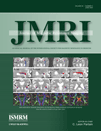Shielded dual-loop resonator for arterial spin labeling at the neck
Abstract
Purpose
To construct a dual-loop coil for continuous arterial spin labeling (CASL) at the human neck and characterize it using computer simulations and magnetic resonance experiments.
Materials and Methods
The labeling coil was designed as a perpendicular pair of shielded-loop resonators made from coaxial cable to obtain balanced circular loops with minimal electrical interaction with the lossy tissue. Three different excitation modes depending on the phase shift, Δψ, of the currents driving the two circular loops were investigated including a “Maxwell mode” (Δψ = 0°; ie, opposite current directions in both loops), a “quadrature mode” (Δψ = 90°), and a “Helmholtz mode” (Δψ = 180°; ie, identical current directions in both loops).
Results
Simulations of the radiofrequency field distribution indicated a high inversion efficiency at the locations of the carotid and vertebral arteries. With a 7-mm-thick polypropylene insulation, a sufficient distance from tissue was achieved to guarantee robust performance at a local specific absorption rate (SAR) well below legal safety limits. Application in healthy volunteers at 3 T yielded quantitative maps of gray matter perfusion with low intersubject variability.
Conclusion
The coil permits robust labeling with low SAR and minimal sensitivity to different loading conditions. J. Magn. Reson. Imaging 2009;29:1414–1424. © 2009 Wiley-Liss, Inc.




